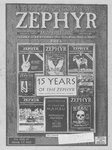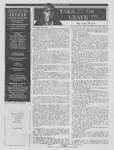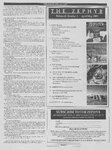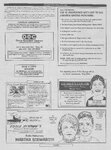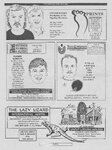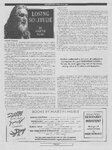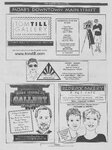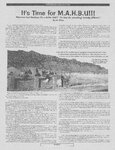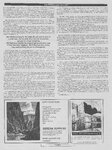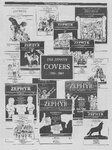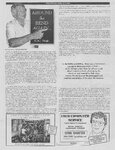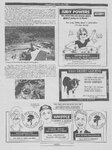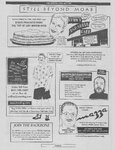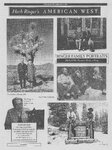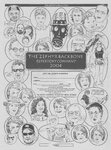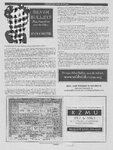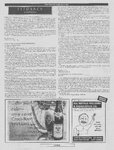| OCR Text |
Show THE ZEPHYR/ APRIL-MAY 2004 taught have stayed with me these many years. I still have a copy of this masterpiece, which deals with the effects of grazing on the arid lands of Utah. What was it that Cottam wrote that made the stockmen so hostile to him? After all, he was one of their own - having been born of rural Mormon parentage in the St. George area. He wrote: A hundred years of struggle against nature in Utah suggests ultimate defeat for man unless more brains as well as brawn are used in the battle. For we have seen many of our springs shrink in volume and some of them fail entirely to discharge their precious liquid. We have witnessed the denudation of our mountain slopes through fire, poisonous gases and unregulated grazing and then like whimpering children have bewwailed the cruel devastating floods that have followed these abuses. We have seen our sparkling mountain streams run red with silt and become sterile of aquatic life . It seems incredible that a full half century of intermittent but devastating floods has not taught an intelligent people the obvious relationships between vegetation, soil, and water. Several different types of native eraser Were once common in the semi-arid southern Utah. The pronghorn ly grazed upon them. However, upon the introduction of cattle and sheep, it took‘only oe a years or so to Oise: these sensitive lands. With, the natural ecosyst altered, ly invaded the former grasslands. And the big sagebrush, a hardy and cold- tolerant shrub spread out over wide areas to dominate much of the ecosystem. During the decades of the 1880s and 1890s there was a tremendous upsurge in sheep population in Utah. The grass-covered mountain ranges of the Wasatch, the Uintas and the high plateaus were overgrazed, and sheep trailing did much damage to the watershed areas. As Cottam noted, from far off one could detect numerous herds of sheep by the clouds of IS UTAH STILL SAHARA BOUND? On Feb 19, 1947, Dr. Walter Pace Cottam, a professor of botany at the University of Utah delivered the distinguished annual Frederick William Reynolds lecture during Utah's centennial settlement year. His subject: Is Utah Sahara Bound? sent shock waves through Utah’s ranching and farming communities. It must have taken great courage to accomplish what he did. The University published his remarks in bulletin form and opponents as well as supporters studied these in detail. Like a bombshell, the fallout continued for months. In my senior year of high school that same year, I gave a talk too at a Future Farmers of America state function in Salt Lake City entitled “Contour Plowing,” a short piece about preventing soil erosion on farm lands. We had already discussed the Cottam address because of its far-reaching impact. After our session, some of us were ushered to the University of Utah where we strolled about the campus and among its beautiful lawn and tree-covered grounds. Ivy crept up the walls of its old buildings. I was so impressed | decided to enroll at that venerable old school. I secured my own personal copy of Cottam’’s speech. He begins: “Could we but turn back the clock of time one short century and on the morrow’s dawn gaze out over this valley asleep in the morning shadows of the Wasatch Mountains, we would see no human habitation, perhaps a few scattered teepees of the red man — no streets, no trees, no smoke. The thought is incredible.” At first, | wasn’t aware of his speech’s continuous impact. Ranchers from across the state criticized him severely. According to Maxine Martz’s Cottam biography, Why Hurry.Through Heaven, the irate stockmen wanted Cottam fired from the University, but University president A. Ray Olpin dust created by their many hoofs. He condemned the extravagant and unbridled exploitation of the plant life resource, and he pointed out how the towns of Sanpete County had been hit with the fury of ravaging floods. “Truly the fathers’ sins against the land are visited upon their children for generations to come, especially when the children continue in the same transgressions,” he said. This statement was born out by the disastrous flood at Mt. Pleasant in July 1946. In the 1880s and 1890s, there was a tremendous upsurge in sheep population in Utah.... As Dr. Cottam noted, from far off one could detect numerous herds of sheep by the clouds of dust created by their many hooves. He condemned the extravagant and unbridled exploitation of the plant life resource. refused to do so. I enrolled in the University that same fall, and I intended to take as many natural resource courses as I possibly could. Eagerly, I signed up for Dr. Walter P. Cottam’s botany class. Cottam became one of my most influential and inspirational professors. He was a tough and exact teacher. He rightly flunked me, after warning me, for cutting too many of his student-assistant lab classes. Rather than attending them, I headed for the trails of the nearby mountains. Though the lab didn’t excite me, Cottam’s lectures certainly did. One day, the esteemed professor led our class on a little walk into a shallow gully behind the Thomas Library (now the Utah Museum of Natural History). There we viewed the lofty trees that he himself had planted — cottonwoods, live oaks, a pagoda tree, a sequoia, and a host of others. He had hybridized some of the oaks that he had planted by crossing southern Utah’s live oaks with Gambel oaks. This produced more hardy oaks that reportedly held their leaves through the winter. At orfe time the University had thoughts of filling in that gully, but Cottam protested and took it on himself to plant trees in it. His hallowed site became reverently known thereafter as “Cottam’s Gulch.” During my venturous five years at the University, I’d often head for that tranquil setting, my arms loaded with challenging lessons and library books. His provoking lectures often He emphasized the fact that in 1903, after the Manti National Forest had been created, the federal government needed to take steps “to protect these people from themselves.” It banned grazing within the entire Manti Creek watershed for a number of years. By using data he collected from Mountain Meadows in Washington County, at the infamous Mountain Meadows Massacre site, he ably illustrated the ecological catastrophe caused by livestock on those delicate meadowlands. The area is still in jeopardy to this day. The Great Basin deserts weren't so green after all, he said. The deserts weren’t “blooming as a rose” as we had all been led to believe in the overblown oratory given in public and church meetings. He revealed to us the processes of range destruction and the extent of damage it inflicted. It all occurred within two or three decades after initial Mormon colonist settlements. The new settlers were ignorant of their impact upon the land. For the years between 1847 and 1937, he cited strong data that native grass cover in Utah's Great Basin went from 45% to nearly zero. Sagebrush increased from 1% to 11%, rabbitbrush rose from 1% to13%, and the juniper-pinyon cover increased from 10 % to 38%. Startling figures. focused on his own revealing work, Is Utah Sahara Bound?. His lectures and the lessons he COW CANYON FRADING& RESTAURANT POST LSCO COMPUTER SERVICE “Twenty Years of PC Experience” REPAIRS UPGRADES MAINTENANCE SOFTWARE LYNN SHAFER 259.5635 BLUFF,UTAH 435.672.2208 lynn@lsco.net PAGEI8 |
